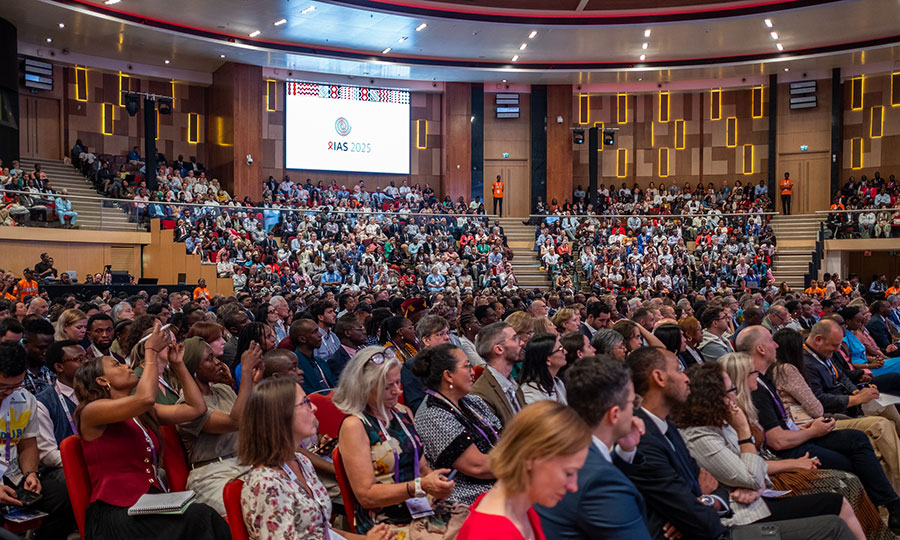CMMB Showcases Innovations in HIV Epidemic Control at IAS 2025

Audience attending the opening session of the 13th IAS Conference on HIV Science. © Jean Bizimana/IAS | Licensed under CC BY-SA 4.0
CMMB’s work in HIV/AIDS dates back more than two decades. Since then, the world has made significant progress in epidemic control, and CMMB is proud to play a leading role in this advancement.
Our global network presented some of this work at the recent 13th International AIDS Society (IAS) Conference on HIV Science, which wrapped up on July 17, 2025. Colleagues from Haiti, Kenya, South Sudan, and Zambia spent four days sharing learnings and gaining new insights into epidemic control.
Explore these six top-line headlines presented by our team of CMMB experts at IAS in Kigali.
1. Ethical index testing and community viral load sample collection, combined with strong collaboration between clinical and orphans and vulnerable children (OVC) programming, improve pediatric and adolescent HIV viral suppression among highly vulnerable sub-populations.
Access to Health Zambia increased viral load coverage from 86.4% to 95.6% and viral load suppression from 87% to 96.9% between Oct. 2021 and Sept. 2024, increasing the likelihood of Zambian children with HIV surviving and thriving. Check out our oral presentation findings here.
2. In Haiti, our optimized care package had similar results for children living with HIV: nearly 86% of children achieved viral load suppression, compared to 60% receiving the standard of care.
Under this approach, children or preteens living with HIV received at least one other targeted intervention in addition to the standard of care, such as directly observed therapy, status disclosure support, individual counseling, or viral load “classes.” For more, please see our e-poster.
3. Operation Triple Zero (OTZ) proved highly successful in improving pediatric and adolescent viral load suppression in the South Sudanese context, adding additional proof that this empowerment approach also works within fragile settings.
Under OTZ, children, adolescents, and young people aged 10–24 strive for zero missed appointments, zero missed doses of medication, and zero detectable viral load. 74% of eligible children and young people had their viral load taken on time from four CMMB-supported health facilities, with 93% achieving viral load suppression (Sept. 2023–Oct. 2024), exceeding current national estimates. More here.
4. Index testing for HIV is possible in a complex emergency environment like South Sudan and should be explored further as part of feasible targeted testing packages in humanitarian contexts.
While our findings on multistrategy targeted testing are consistent with other countries in terms of modalities and yields, they demonstrate that an adapted HTS package for emergency contexts is important to accelerate progress toward the first 95, which currently stands at 35% nationally. More here.
5. Quality improvement is critical when it comes to reducing vertical HIV transmission in South Sudan, reinforcing the importance of introspection and analysis when deploying interventions.
With estimated vertical transmission rates reaching 25%, CMMB South Sudan analyzed programmatic data from 13 counties of Western Equatoria and Central Equatoria States from Oct. 2023 to Sept. 2024 to identify which structured interventions and capacity-strengthening approaches worked most effectively to increase identification and linkage of HIV-positive pregnant women to testing and treatment. More here.
6. WhatsApp serves as a powerful, cost-effective tool in the arsenal to boost access to justice and strengthen case management for sexual- and gender-based violence survivors in Kenya.
Under CMMB Kenya’s innovative sexual and gender-based violence (SGBV) prevention and response program in Siaya County, we set up a centralized encrypted communication platform for young paralegals that improved timely reporting of new cases, communication on court dates and requirements, and bolstered court appearance preparation. As a result: case identification and follow-up increased 150% and sexual offense reporting surged 383% from 2023 to 2024, and case completion rates rose from 34% in 2022 to 74.6% in 2024 while backlogs were cleared. Six months post-project, the practice was sustained without donor support, as paralegals continued to strengthen referral structures. More here.
For more information or questions, please feel free to contact us!